This is a sudden uncontrolled involuntary muscle contraction that can be painful. The most common site is the calf muscle but other lower limb muscles are also prone to cramp.
There is usually a disturbance of normal nerve control or of normal muscle physiology. Other reasons for cramp have been put forward but nerve control issues is now the most popular.
Treatment is therefore directed mostly at reducing the excitability of the motor nerves of the muscle by reflex inhibition and sensory nerve stimulation.
There is no guaranteed perfect prevention strategy against cramps but the following are considered helpful:
- Regular muscle stretching
- Adequate training for the activity
- Correction of muscle imbalances
- Good static + dynamic postures
- Good mental preparation
- Avoid of provocative drugs / medications
- Including eccentric activities and plyometrics into training
- Adequate hydration, nutrition + recovery
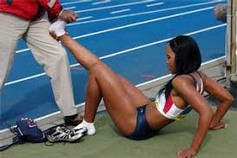
The hamstring muscles are frequently injured in sporting activities.
Usually it is injured at the end of the leg swing, during kicking actions, or during accelerating at the start of sprinting.
Hamstring muscles have a number of functions including pelvic positioning / posture and preparing the limb for loading during walking and running. It extends over two joints - the hip and knee. It is largely a postural muscle and so not best suited to very high intensity activity.
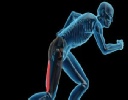 Risk factors for injury include:
Risk factors for injury include:
- Previous injury
- Increased tightness in muscle
- Age
- Reduced flexibility
- Reduced Strength
- Low Back Pain
Muscle Injury Severity
All muscle injuries are graded to give an indication for severity and to help direct treatment / prognosis / gauge return to sport
- Grade I - small number of fibres affected, causes localised pain but no loss of strength
- Grade II - affects significant numbers of fibres, causes pain, swelling and pain on use of muscle with associated loss of strength and flexibility
- Grade III - Complete tear of the muscle, usually at the junction between muscle and tendon

Treatment
RICE regime
Activity:
Without pain in shortened position, including static work, gradually increasing in ROM + intensity
‘Activation’ of the core
Separate + combined lumber movement and leg movements
Dynamic jogging / running without pain or limp
Technical drills: sidestepping, hurdle walk over, sumo walk,
lunge, high knee walk, heel flicks
Gentle Stretching of hamstrings starts after 5 days
Strengthening programme – general and sport specific
This usually occurs in contact sports when one player accidentally makes strong physical contact with another player, usually on the thigh muscle or upper arm muscles
The incoming body part crushes the muscle fibres against the
bone underneath, crushing it and causing localised bleeding within, and around, the muscle and possibly bruising + swelling will develop later. This is very common on the thigh where it is referred to commonly as a ‘dead leg’
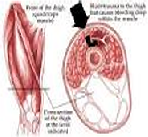
The injured player usually has difficulty using the muscle after the injury and bending the joints moved by the muscle. This would be the knee in the case of the thigh being injured.
It is critical to avoid causing further bleeding over the following 10 days after the injury. Severe injury, including where bleeding is not dispersed and appears as bruising, can lead to bone formation within the muscle which can be a major complication. This is called myositis ossificans.
Treatment
RICE Regime with the muscle placed on on maximum pain free stretch during icing
Gradual return to daily activity - without provoking pain
Massage Therapy after 48 hours min.
Functional Rehabilitation Exercises / restore strength.
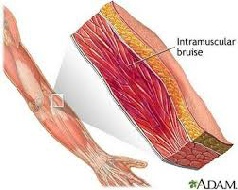
Muscle Contusion
Muscle tissue is prone to injury like all tissues, but its dynamic nature makes it somewhat different to other non elastic and contractile tissues
Muscle tissue is contractile and elastic. Therefore it is better able to withstand sudden applications of forces applied along its length.
 The injury is described as a strain where it refers to muscle tissue. The muscle fibres are damaged when they fail to cope with the demands on them. Muscles are most likely to tear during sudden acceleration or deceleration. Other factors to affect the risk of injury is if they are operating over two or more joints, if there is external compression on them or if they are attempting to work in an un-natural manner - working to maintain posture when they are a power muscle or vice versa.
The injury is described as a strain where it refers to muscle tissue. The muscle fibres are damaged when they fail to cope with the demands on them. Muscles are most likely to tear during sudden acceleration or deceleration. Other factors to affect the risk of injury is if they are operating over two or more joints, if there is external compression on them or if they are attempting to work in an un-natural manner - working to maintain posture when they are a power muscle or vice versa.
Muscle strains are graded according to severity
- Grade I : a small number of fibres are damaged and cause localised pain but no loss of power / strength.
- Grade II : A significant number of fibres are torn and there is associated pain and swelling. Pain is present on contraction of the muscle and there is loss of strength and active range of movement.
- Grade III : This is where there is a complete rupture of the muscle with associated pain, bleeding, bruising and loss of active movement produced by the muscle - note many movements are produced by a number of muscles so some movement may be possible if done by other muscles.
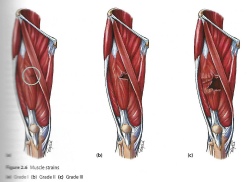
Predisposing Factors for Muscle Strains
- Inadequate Warm Up
- Insufficient joint Range of Movement
- Excessive muscle tightness / low flexibility
- Excessive muscle tone / tension
- Fatigue / Overuse / Poor Recovery
- Muscle Imbalances
- Previous Injury
- Poor Technique / Biomechanics
- Spinal Dysfunction
First Aid - PRICE - will minimise bleeding and swelling. The aim is to get the inflammatory stage completed as quickly as possible so that scar tissue is formed.
The Rehab programme then aims to gradually strengthen the damaged muscle tissue and the scar tissue to full tensile strength which can cope with any demands placed on it.
This will include gradually increasing the resistance and stress the muscle has to work against until it is fully functional and normal quality movement has been returned.
Treatment of Muscle Strains
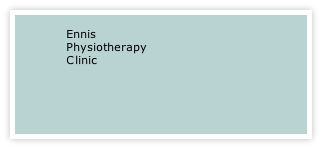




Mon - Fri 9.30am - 8.30pm


3A Barrack Close, Barrack St., Ennis, Co. Clare V95 X437

065 6840757
| Health+Safety Services |
| Sports Clubs+Teams Services |
| Standing Posture |
| Sitting Posture |
| Childhood Posture |
| Using Portable Devices |
| Normal Walking |
| Running |
| Running Drills Videos |
| Muscle Energetics |
| General Fitness |
| Losing Body Weight |
| Gaining Body Weight |
| Weight Loss Programmes |
| Start to Run |
| Start to Swim |
| Start Cycling |
| Start Nordic Waliking |
| Rehab of Tensdons |
| Loading of Tendons |
| Non Specific LBP |
| Posture |
| Intervertebral Disc |
| LBP Treatment |
| Non Specific Neck Pain |
| Neck Care Advice |
| Hamstring Strain |
| Ankle Sprain |
| ACL Injury |
| Joint Replacement |
| Shoulder Dislocation |
| Tennis Elbow |
| Wrist fracture |
| Fractured Knuckle |
| Selecting a Racquet |
| Racquet Grip Size |
| Racuet Sport Injuries |
| Training for Racquet Sports |
| Ski + Board Injuries |
| Injury Videos |
| Injury Prevention |
| Preventing Injury in Musicians |
| Irish Dancing |
| Preventing Dance Injury |